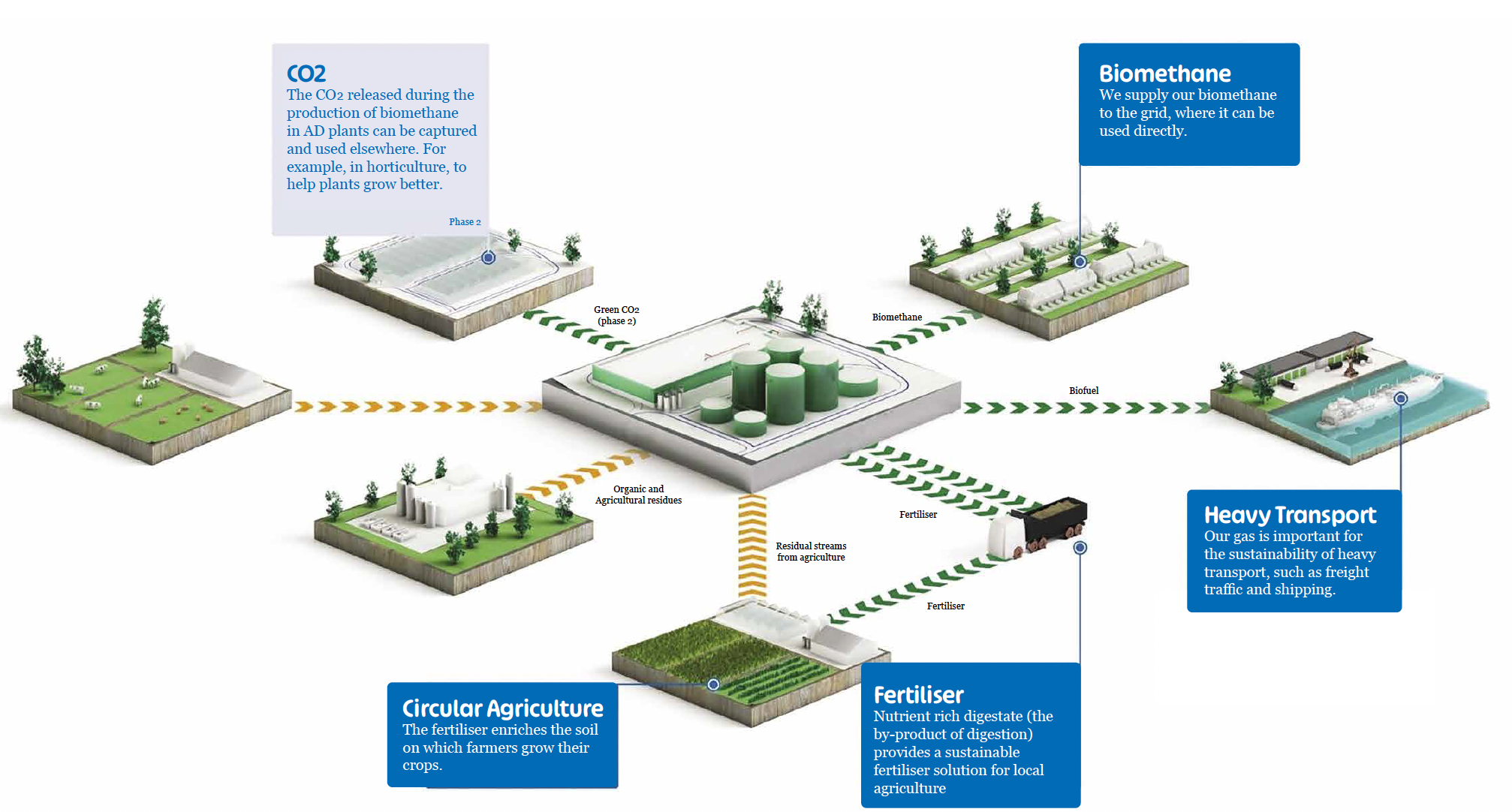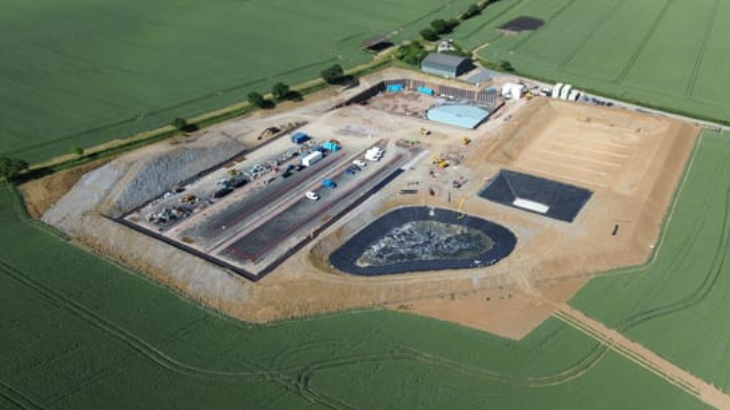Greener Pastures: How ‘Mechanical Cows’ Are Redefining Rural Energy

VIDA Bioenergy is a wholly owned subsidiary of VTTI, a global leader in energy infrastructure, based in the Netherlands. VIDA bioenergy was launched in January 2025, with the aim of it becoming one of Europe’s leading biomethane producers, dedicated to transforming biomass into renewable energy.
As a new developer, Vida Bioenergy is currently smaller than the giants such as Future Biogas or Biogen but amongst the mid-sized developers like Acorn Bioenergy, Bio Capital and GENeco.
Its first UK project is Glentham Green Energy in Lincolnshire, which opened in Q1 2025, and began injecting biomethane into the National Transmission System (NTS) in February 2025. The NTS is a high-pressure pipeline network that transports gas from various sources (the North Sea, South Wales and South East England and Europe) to the five regional gas distribution grids, gas power stations and some industrial manufacturing facilities, from where it is distributed to homes and businesses. It is the gas equivalent of the National Grid, our electrical power transmission network.
Glentham Green Energy processes straw, chicken manure, potato waste, and sequential crops (second crop grown in the same field and same year as a food crop), producing over 60 GWh/year—heating roughly 5,200 homes. Besides biomethane, it generates liquid CO₂ and digestate, an organic fertiliser used locally to replace synthetic alternatives.

Its second UK project is right here in West Northamptonshire, the Wormslade Green Energy Anaerobic Digestion Plant, located between Kelmarsh and Clipston just off the A508 linking Northampton and Market Harborough.
The plan is for the Wormslade plant to process over 45,000 tonnes of crops and agricultural residues each year, primarily sourced from local farms. Construction began on January 6 2025 with completion expected by Q4 2025, and full commercial operation targeted for late July 2026. The site features major community infrastructure upgrades: road widening on Clipston Road, utility enhancements (National Gas, Openreach, Gigaclear), and plans to plant over 4,000 native trees and hedgerow plants to boost local biodiversity.
VIDA Bioenergy has other greenfield sites in planning which they hope to start building later in 2025.
A method for breaking down organic matter (food by-products, sewage sludge and other biodegradable materials) using microbes in an environment with no oxygen. The process produces bio energy and ‘digestates’ or ‘biosolids’ which can be used as a sustainable bio-fertiliser, returning nutrients to the soil and reducing reliance on chemical alternatives.
There are approximately 720 operational AD plants, including both biogas and biomethane facilities, as of mid-2024/early 2025.
Why Northamptonshire?
To build a successful Anaerobic Digestion (AD) plant, you need 4 key things and the Wormslade plant fulfils them all.
1) Proximity to a gas pipeline with ability to take on a new supply of gas.
2) An agricultural area with an abundance of feed stock and residues.
3) Access to land that can make use of the organic residue.
4) Access to land with space and without close neighbours who might object.
Building an AD plant is a high risk, with high build costs. Wormslade has been a prospective site for various developers over the last 10 years, with VIDA Bio Energy finally able to bring the project to fruition.
How is this related to my gas bill?
If you are a gas consumer, approximately 6% of your bill is related to green levies. Part of this goes into a pot of money and is redistributed to qualifying schemes. The Green Gas Support Scheme (GGSS) is a government environmental scheme that provides financial incentives for new anaerobic digestion biomethane plants to increase the proportion of green gas in the gas grid. Bio energy is a vital component of the global shift toward sustainable and renewable energy sources.
Registered participants will receive quarterly payments over a period of 15 years, based on the amount of eligible biomethane injected into the gas grid. The scheme closes for applications on 31/03/28 so the next 9 months will see more applications from developers, such as VIDA Bioenergy, looking to take advantage of the GGSS and needing to enter the planning stages by Q1 2026, as this can take up to two years. It is a competitive process and many developments fail in the planning stages.
Areas of controversy surrounding AD plants
Critics argue that growing crops for energy displaces land that could be used for food production, which is a particularly sensitive area in times of rising food prices and food insecurity. In the UK, maize grown for AD has replaced some traditional food crops.
Maize cultivation, especially, is associated with soil erosion due to late harvesting and bare soils over winter, nutrient runoff and water pollution, contributing to algal blooms, poor water quality and loss of biodiversity, especially when energy crops replace diverse grasslands or hedgerows. In 2015, the UK Environment Agency warned that maize-for-AD was causing “significant soil damage” in some areas.
Energy crops require dedicated agricultural land which can lead to increased land rents, pricing out smaller farmers, pressure to convert marginal or conservation land into productive acreage and also creates competition for land with rewilding, housing, and carbon sequestration goals.
While AD is often billed as "carbon neutral", using energy crops can reduce its environmental benefits because growing the crops involves fertilisers, diesel and emissions from land-use change, and the carbon savings may be less than claimed, especially when compared to using genuine waste as feedstock.
People fear the roads will be filled with trucks bringing crops and waste to the plant and that the plant will give off ugly odours. In Wormslade’s case, most of the transport will come down from the A14 along the A508 therefore not affecting too many villages, with the vast majority coming from within a 30-mile radius. In terms of the smell, the Wormslade plant will not process food waste, and additionally the digestate lagoon will be covered with odour abatement fitted which was not something that earlier AD plants tended to do.
Response to these controversies:
To address these concerns DEFRA and the Environment Agency issued guidance discouraging high-maize content in AD feedstock and the Non-Domestic RHI later capped the proportion of energy crops eligible for subsidy. And the Department for Energy Security and Net Zero produced a 2023 Biomass Strategy that requires at least 50% of biomethane energy content to come from waste and residue feedstocks, not crops.
As a result, many newer AD plants are now shifting towards waste-based feedstocks (e.g. food waste, slurry, crop residues) and sequential cropping or cover crops that reduce soil erosion and don’t displace food.
Where’s the middle ground?
Some experts suggest that a small proportion of energy crops can be justified to stabilise AD performance and the key is using marginal land, rotation-compatible crops, and strict sustainability criteria. Emphasis should also be placed on life-cycle emissions, local food security, and soil health.
What about local farmers?
They stand to gain significantly from the plant’s presence. Many will supply the organic feedstock used in the digestion process—such as crop residues and manure—providing a new revenue stream and a more sustainable way to manage farm waste. In return, they receive digestate, a natural biofertilizer rich in nutrients that can improve soil health and reduce the need for chemical fertilisers. This creates a closed-loop system where farm inputs and outputs are more efficiently managed.
Working with the local community
The Wormslade plant wants to be a ‘decent neighbour’ says UK General Manager Rob Richards. They want to bring tangible benefits to the local community, both through job creation in the construction of the site and through ongoing operations. Wormslade will employ around 5 people, but will also use local suppliers for support services, engineering, transport etc.
Vida has conducted extensive consultations with local residents, parish councils, and community groups throughout the planning and early construction phases. In Feb 25, they held a session in Great Oxendon with about 50/60 people turning up and they held a second session in July in Clipston which was also well-attended and received. They also plan to send out leaflets to surrounding villages and through Parish Councils, local Ward councillors and via Facebook.
These sessions have helped and will continue to address local concerns, share plans transparently, and adjust project details - such as transport routes and operating hours - based on feedback. For example, road improvements on Clipston Road were incorporated into the development specifically to address community access and safety concerns.
Additionally, the Wormslade site includes plans for the planting of over 4,000 native trees and hedgerow species, a move designed to enhance biodiversity while acting as a visual and environmental buffer for nearby properties. Vida also plans to host educational visits, offering schools and local organisations the chance to learn about renewable energy, sustainable farming and waste reduction first hand.

